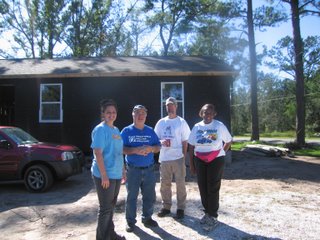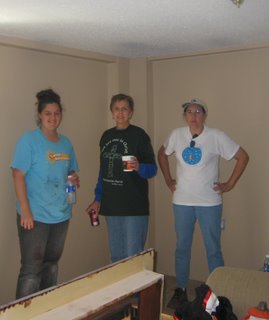 More about our week with the hurricane disaster recovery:
More about our week with the hurricane disaster recovery:The work assignments were a little chaotic, themselves bearing witness to the PDA motto. There are many teams of people in the gulfcoast area offering help with a wide assortment of skills. There’s no strict requirements for the work-- you don’t have to be a licensed plumber or electrician to do the work, so that frees things up a bit. But sometimes PDA scheduled work for us only to arrive at the house to find the work had been done by someone else that PDA didn’t even know about and we weren’t needed. It only stands to reason that people will take any help they can get whenever it’s offered and to hell with anyone’s “schedule.”
Dallas spent the week trying to sweet talk some guy into letting us inside his house to gut it so he could begin the re-building process. He still wasn’t ready and had been living in one room without electricity or water for over a year now. She called him every day and would report to us that he was almost ready but not quite.
The town of Pearlington was easy to work in because it’s a small town and everybody knows each other. There’s only about 1,600 people there and maybe only 2 or 3 neighborhoods. It doesn’t take long to get to a job site. It was called “the town that American forgot” because they went six weeks before any volunteers showed up. With a mixture of blacks and whites I never detected an attitude of racial discord even after somebody said it was an old center for the KKK. The hurricane certainly didn’t make any distinctions. When a young white man died the week we were there the black church took up a collection for his funeral.
Our first day we went to Johnnie and Evelyn’s house. Their house was washed about a couple of blocks away and they got a new one from Walls of Hope. These are kit houses. The lumber is cut and organized in Iowa. They can fit three houses onto one 18 wheeler and ship it to Mississippi. Check out their website: http://www.wallsofhope.net/.
 Here's a picture of Emily, Beaven and Clay with Shirley Thompson in front of her Walls of Hope house.This is what the Walls of Hope houses look like after the whole kit has been built. Shirley
Here's a picture of Emily, Beaven and Clay with Shirley Thompson in front of her Walls of Hope house.This is what the Walls of Hope houses look like after the whole kit has been built. Shirleymust provide the siding and the interior work.
The Walls of Hope kits will provide walls and a roof with shingles. It’s constructed by volunteers so the only thing you pay for is the lumber. Johnnie and Evelyn got one of the biggest houses but they are housing eight people. We never were clear how everybody in their family is related to each other but we also ran into a lot of families arranged this way. Johnnie and Evelyn are putting up their own siding and will arrange for the plumbing and electricity. Our team was sent to build a wrap-around deck. It took the men a while to measure and commence digging the holes for the posts so the rest of us watched a mother and son couple from Canada putting up siding.
I loved their story. Ilene is a retired principal and her son, Alex, looks around college age. We knew they were mother and son well before we introduced ourselves because she was telling him what to do all the time and he obviously didn’t agree with her. This was their third trip to the coast. They weren’t part of any organized group. They just got on a plane and came. They contacted a guy in the area people call “Canada John” and he arranged for them to stay in a FEMA trailer. They just got on a plane and came. When we got there they were about half-way finished with the siding and a couple of our gals climbed up on the scaffolding to help
Emily and Ila siding Johnnie and Evelyn’s house.
One of the great things about this work is that most of it is really easy once you start doing it. It’s just that most people never have an opportunity to put up a few sheets of siding without having to order it, pay for it, wait for it to be delivered, put up the scaffolding and live with the consequences of what happens if you do it wrong. Siding was like that. A huge job if it’s your own house, it becomes just a matter of a couple of nails here and there when all the ground work has been done for you. After a while Dallas came by and told us Shirley Thompson needed people to unload sheetrock that was being delivered. Since the siding was really the Canadians’ project we went to help unload the sheetrock.
We had already met Shirley’s mother, Annie Oliver, a precious little 87 year old lady. Small and soft-spoken, Miss Annie didn’t say much or move much but you could tell she was one of the neighborhood’s most beloved ladies. She and Shirley both had Walls of Hope houses. Shirley told us her mom chose a floor plan that had a hall down the middle of the house because she
had never had a hall before.
Unloading sheetrock is one of the most underappreciated jobs in the world. Sheetrock is heavy. And bulky. To top it off, these sheets were the twelve-foot sections, not the wimpy eight foot kind. We eventually developed a technique where two people would stand at the stack in the front yard where the delivery truck had left it, pull a sheet toward them, pivot it down and slide it off the stack then lift it and carry it over to the front door. At the door, another team of three people would receive the sheet and haul it up to the doorway where another person joined the effort and all four carried it inside and onto the indoors stack. We huffed and puffed our way through this job and, by taking numerous breaks so our muscles wouldn’t go on strike, we eventually got 140 sheets of the stuff inside.
On our second day of work we started putting up the sheetrock. Half of our team, mostly the women, did the walls, starting with the section at the floor. The men of our team worked on the ceiling using a special piece of equipment that balanced a whole section and held it while they could crank it up against the ceiling. The men loved this gadget and spent a lot of time balancing and cranking. The women worked faster than the men in spite of the men having special quipment. Again, sheetrocking is much easier than you think once you try it.
We heard through the grapevine that Johnnie’s 24 yr old nephew had died, apparently of a heart attack. When we went to lunch at the Missionary Baptist church that day they announced the death and took up a collection “so we can get this boy buried,” because the family didn’t have any money for the funeral. I got the impression this happens here a lot and money
started showing up in the basket they had put out.
started showing up in the basket they had put out.
On our third day of work PDA had a new team at camp who claimed to be very experienced at sheetrock (translation: they can put up more than one sheet on the ceiling in a day.) So, after a few phone calls around town, we were sent out to paint Michael and Susan Hanley’s house. This was the house where the ocean traded them crabs for catfish. Their house is brick and was
still standing after the storm but the interior was under water and had been gutted. With all of us working together, we made quick work of it and even invented a new technique for staining 12ft sections of trim wood. We could do the job in three seconds per section. Ila and I were quite taken with our skills but no one else seemed as impressed.

Emily, Ila and Chris finish painting the Hanley's house
None of the stuff we did was very hard. We enjoyed working with each other. It was very empowering to most of us who had never done some of these things before. Eight people and three days of work. We were only a small part of the recovery but we did a lot more than meets the eye. Monday night new teams arrived and one group in particular impressed me: SWOOP. Their website is http://www.swoop4u.org/. It stands for Strong Women Organizing Outrageous Projects. In North Carolina where they live they will swoop in and do a day’s work of mostly construction for women in need. They found out PDA had housing facilities and came to Pearlington. When devotion time was announced they looked kind of startled at this new idea of a devotional being part of their work. Someone looked around sheepishly asking “Do we have anybody in the group who is religious?” But when Miss Annie sat in her chair and belted out “Precious Lord” they were overcome by tears.
Precious Lord, take my hand
Lead me on, help me stand
I am tired, I am weak, I am worn.
Through the storm, through the night
Lead me on to the light
Take my hand, precious Lord
Lead me home.
Shirley Thompson summed it up: She told us she had prayed for people justLead me on, help me stand
I am tired, I am weak, I am worn.
Through the storm, through the night
Lead me on to the light
Take my hand, precious Lord
Lead me home.
like the PDA to come. “Lord, send us help. You know we can’t do this by
ourselves. Send us some help. They will know how to help. They will know
how we’re feeling.” She never had any doubts we would come.


No comments:
Post a Comment